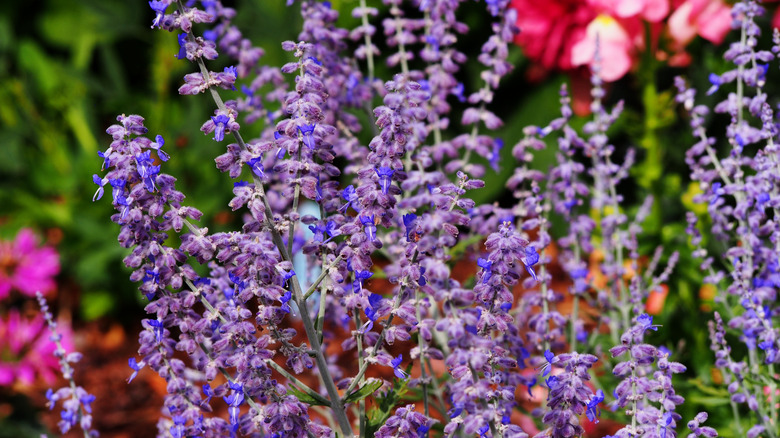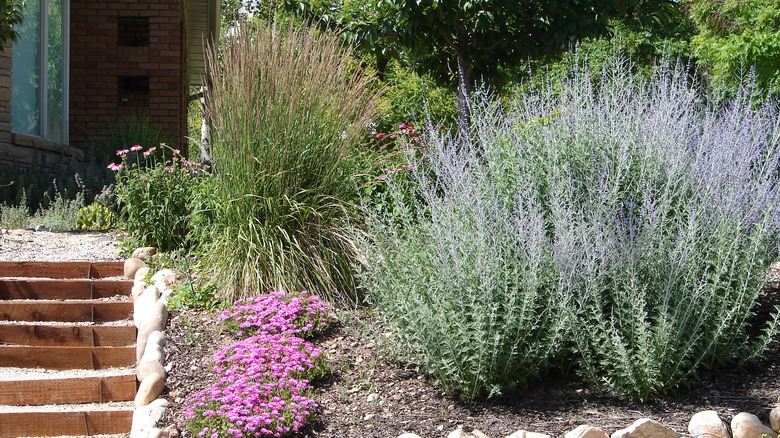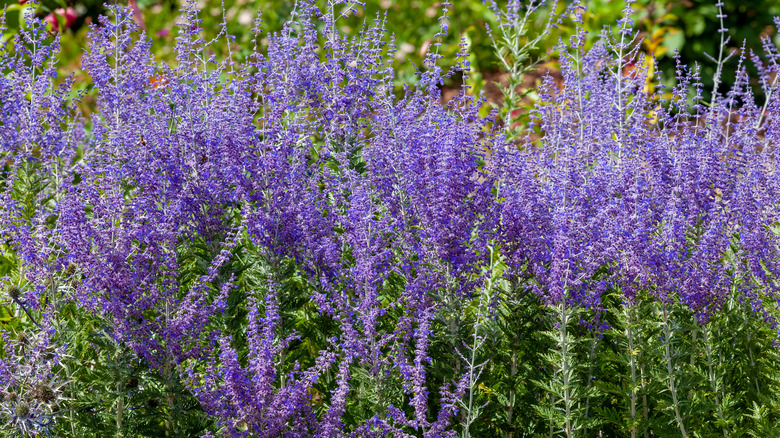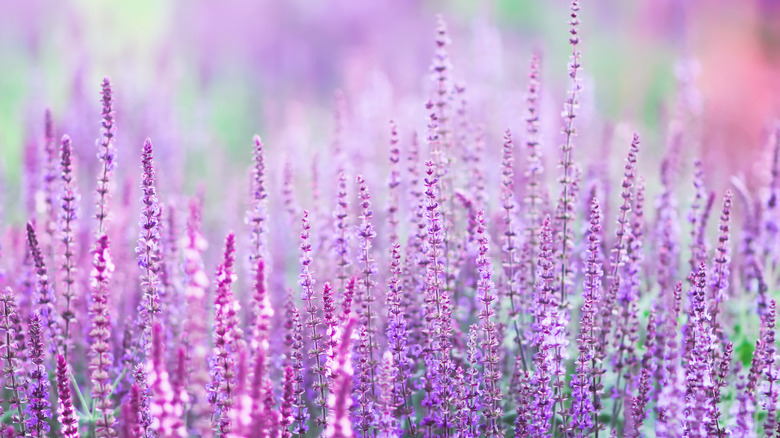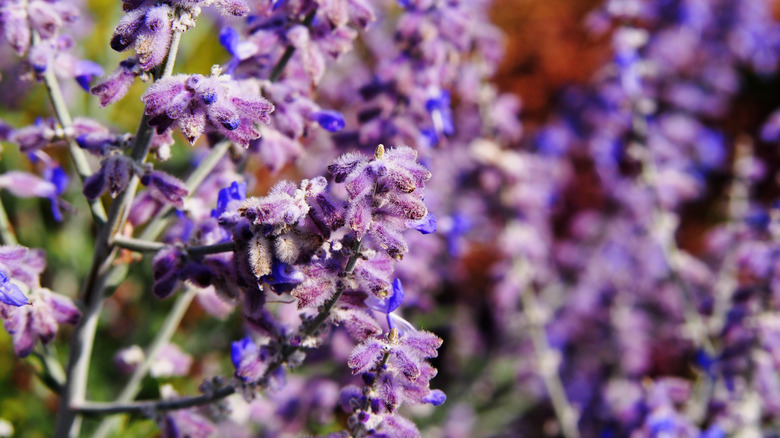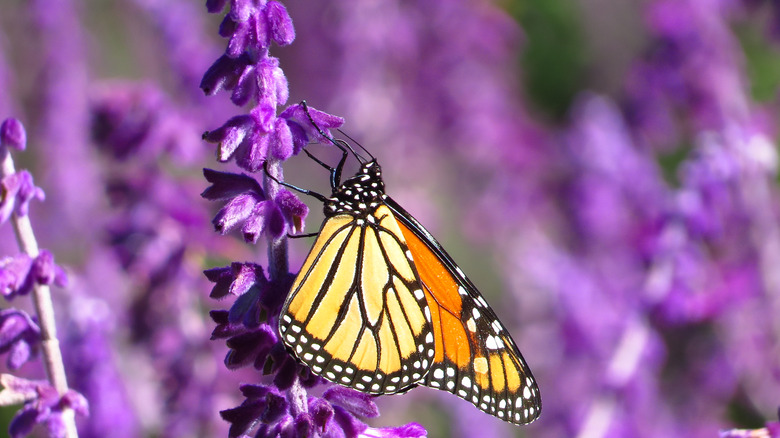How To Successfully Grow Russian Sage Plants
Referred to previously as Perovskia atriplicifolia, Salvia yangii or Russian sage is a perennial shrub in the mint family, the North Carolina Extension Gardener Plant Toolbox writes. As with many plants in the Lamiaceae family, it gives off a distinctive, pungent scent when its leaves or flowers are crushed. This plant is not toxic to animals, pets, or humans; thus, it can be grown in the garden at will.
Missouri Botanical Garden tells us that the Russian sage is native to some parts of Asia, including the Himalayas and Western China. Like other plants in this area, this is drought-tolerant, low-maintenance, and has an extra-long blooming period. Salvia yangii is characterized by long, square, and silvery stems which produce small lavender-like blooms from July to October. As per The Spruce, Russian sage plants can grow as tall as 4 feet high and 3 feet wide. At first glance, the shrub may be easily confused with lavender, even though it tends to grow quite a bit larger and doesn't smell as nice.
How to use Russian sage in the garden
Russian sage is used almost exclusively in the garden. It is a relatively hardy plant, capable of growing in USDA hardiness zones 4 through 9, as explained by Garden Design. Many gardeners use it as a border plant, a filler plant in bright garden beds, or on a xeriscaped lawn. Russian sage attracts pollinators like bees, hummingbirds, and butterflies, which can help nearby flowers, The Spruce notes. They are also resistant to deer and rabbits.
Salvia yangii can be grown alongside an array of other plants and flowers. You can create beautiful color combinations against its muted purple blooms or silvery gray-green foliage. Better Homes & Gardens suggests planting phlox, daylilies, black-eyed Susans, or Milkweed as companion plants to your Russian sage to bring out the very best in each other. Yet, don't let us put you in a box. There are countless ways to plant and style this beautiful purple flora in your backyard. Consider a drought-tolerant succulent-dominated garden plan or a garden full of famously easy to care for flowers and shrubs.
How to grow Russian sage
Growing Russian sage is easy. All you need is well-draining soil and a sunny spot. Most people buy small containers of young Salvia yangii from their local garden center to plant outdoors in the spring, as per HGTV, but you can also propagate your own from cuttings.
Before propagating, though, you will need some supplies, including sterile scissors and a small pot. Start the process by taking one or more 4-inch cuttings of your Russian sage's stems. Make sure you cut just below one of the leaf nodes for the best results and take all the lower leaves off. Next, you'll want to prepare your potting soil. You can use well-draining soil if you have it on hand, but Growing the Home Garden suggests using a mixture of sand and peat. Pack it into a small pot once you have decided which medium you'll be using. You shouldn't need rooting hormone before sticking your Russian sage stems directly into the soil; these are not hard-to-root plants. After you plant your stems, give them some water to moisten the soil, and cover them with plastic to help keep the humidity in. When two to four weeks have passed, they should be ready to plant with their brand-new healthy root system.
How to care for Russian sage
Russian sage is something you plant in your garden and forget about for some time. As long as you give it decent growing conditions, to begin with, the plant should thrive happily for years to come while you lightly prune and water it. According to HGTV, the most important thing you should know about your Russian sage plant is that it loves sunlight. In fact, it does best in areas with full, direct sun.
When watering this plant, do so sparingly. Newly planted Russian sage needs more water than those already established in your garden, explains The Spruce, so water the perennial subshrub only during exceptionally hot days as needed. Normally, rainwater is enough for them to survive throughout the year. Moreover, you'll need to fertilize your Russian sage even less often than you water it. In fact, you may never fertilize it at all. Though, if you are worried about its progress, sprinkling a light layer of compost near its base in the spring will help it thrive even better, says Garden Design.
Russian sage varieties
There are more than 900 species categorized in the Salvia genus, making it the largest genus in the Lamiaceae family, as per the American Journal of Botany. However, not all of the species are native to the Himalayas and Western China, like Russian sage. Most of them have been traced back to South America and Central America. Still, most species in the Salvia genus bear a resemblance to each other in their bushy growth habit and flowering stems. Here are a few great varieties of Russian sage as told by Garden Design.
- Blue Spires can reach a height of 4 feet, making it one of the tallest cultivars of the Russian sage plant. Besides its size, it looks pretty similar to the standard Salvia yangii.
- Lacey Blue is a dwarf variety that grows no bigger than 2 feet tall and wide. Its small size makes it a great option as a container plant to be grown indoors or outside.
- Crazy Blue is the variety whose name gives away its distinctive feature. This plant is truly crazy blue, with a compact, bushy shape to it.
- Blue Steel grows and flowers faster than any other cultivar. If you plant it in the spring, it will likely flower in its first year.
- Denim n' Lace is a popular, award-winning variety of Russian sage characterized by strong, upright stems with purple-blue flowers.
How to repot Russian sage
Repotting can be stressful for many plants, and Russian sage isn't an exception. So if you want to plant it or move it somewhere else in your garden, ensure you get a Salvia yangii with plenty of healthy roots, a section of your garden that doesn't collect too much water, and a shovel. The Spruce says to start this process by first digging a hole in your garden that is about as large as the pot or place your Russian sage is currently in. Then, gently remove your plant from its container or the ground and take the excess potting soil from its roots with your fingers or a gardening fork. Once the rootball is mostly exposed, you can place the Russian sage into the hole you dug.
Pack soil around the sides and on top of the plant's roots while holding onto the base of the subshrub. After you first plant your Russian sage, it will need to be watered thoroughly to help it settle into its new home and establish its roots. Keep an eye on your Salvia yangii for the next few days to make sure it can support its own weight. If stems begin to droop, you may need to help it out with some hoop stakes, as per HGTV.
